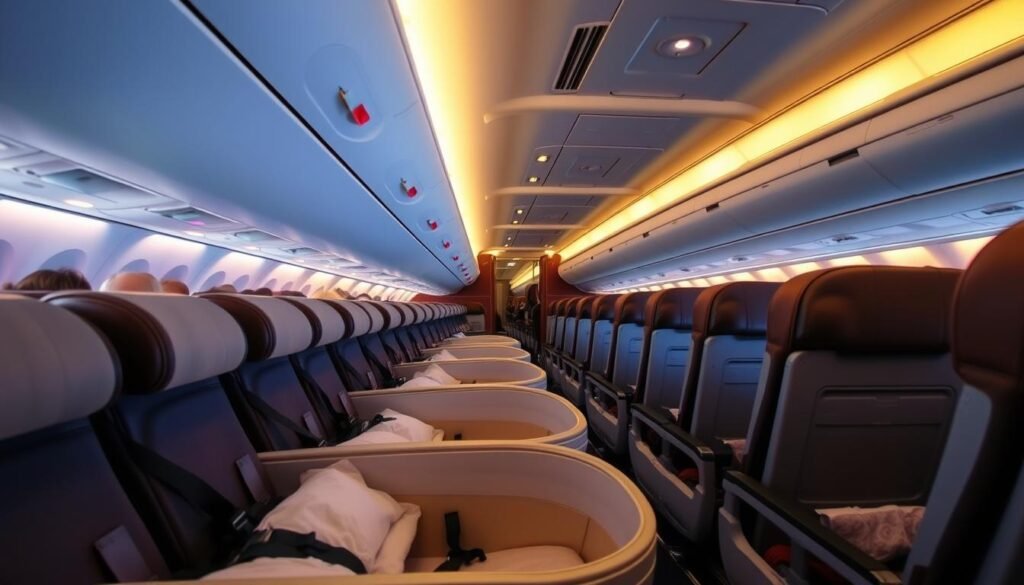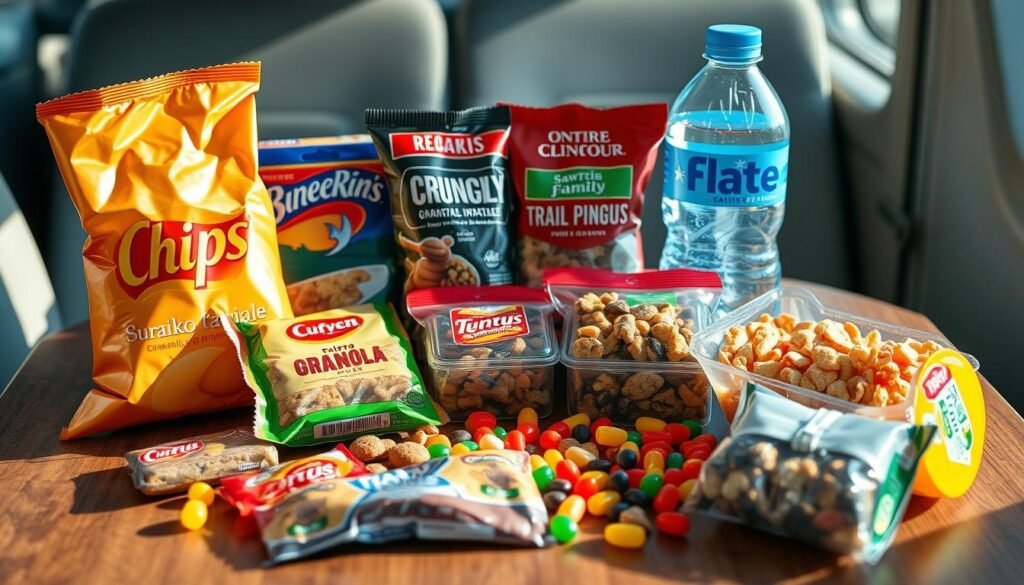I wrote this guide to share the flying with young kids tips I wish I’d had when my family first started to travel. I remember juggling bags, a car seat, and a tired child at the airport and feeling overwhelmed.
Over dozens of trips I learned small changes that made everything much easier. Choosing mid‑morning departures helped sleep windows, packing leakproof bottles and snacks solved food and water issues, and keeping documents handy cut stress when we landed in a new country.
I want you to feel like you are in control, not at the mercy of delays. My plan walks through the plane time, how to manage take and landing pressure, and simple swaps that calm little ones fast.
Use this short, practical guide to make sure your travel day becomes a family win instead of a long scramble. I’ll share the things I still rely on every trip so your next journey saves time and keeps everyone calmer.
Set yourself up for success: choosing flight time and setting expectations
Choosing the right departure can turn a chaotic day into a calm one for the whole family. I base decisions on energy windows and past wins so each trip feels predictable.
Why early and mid‑morning flights make everything easier
Mid‑morning has been my sweet spot: the kids wake up rested, the airport is quieter, and boarding runs much easier. Early flights also tend to leave on schedule and cut down on delays.
I aim for early evening boarding on overnight routes so the cabin meal and lights‑out line up with my child’s sleep. If I can’t get the perfect slot, I plan around the strongest wake window and pad our schedule.
Prepping your child with “airplane rules” and what to expect
Before we head out, I run through the plane day—from check‑in to security to boarding—so there are no surprises. A short “airplane rules” chat (quiet voices, feet off seats, hands to ourselves) is a good idea that really helps.
I arrive early so little ones can move, snack, and use the restroom. I also tell the flight attendant if I’ll need hot water, a bassinet, or help with a stroller. Even a five‑minute expectations talk in the car can change behavior on board.
Pack smart: my family carry‑on and suitcase strategy
I learned to travel lighter by sharing a suitcase when it made sense. That single move cut the number of items I tracked and gave me one less thing to lose at the carousel.
The one carry‑on rule and sharing strategy
I stick to one carry‑on per person and often share a suitcase. Sharing means fewer pieces to chase after and a simpler airport routine.
Spotting luggage and checking weight
To make sure I can identify our bags instantly, I buy bright checked luggage and add bold tags. I also weigh each bag at home because kiosks may not average allowances.
Grab‑first essentials at the front
My grab bag lives in the front of my personal item and holds spare clothes for me and my child, pull‑ups, a small medicine kit, and a leakproof water bottle.
- I pack a few tiny toys and double‑bag messy items.
- I portion snacks and carry an empty bottle to fill after security so kids get fed quickly.
- For tight connections I move one set of clothes per child into carry‑ons to protect first‑night sleep.
Airport game plan: arrive early, move those little legs, and strap in
I keep my airport routine simple: extra time, clear roles, and gear that helps us move fast. This makes the day predictable and gives everyone a fair chance to settle before we board.
Strollers, carriers, and gate service realities
For babies under 2 years old I use a carrier; it frees my hands and keeps the child close. For children up to about 4 years of age, a compact travel stroller is a game changer.
Gate‑to‑gate stroller returns work roughly half the time, so I plan for the chance that I’ll carry my child to the jet bridge and retrieve the stroller at oversize baggage.
Security hacks: snacks and activity bags for TSA
I make sure all snacks are portioned into small serving‑size bags, then group them into one large ziplock for quick screening.
- I arrive early so my little ones can run and burn energy; that protects sleep once we’re airborne.
- I keep IDs, passes, and meds in one pouch and brief my family who carries which bag.
- If I’m solo, I politely ask a flight attendant or gate agent about family boarding or ground assistance.
Boarding and seating: bassinet rows, window seats, and bag placement
Boarding is the small battle that often decides how calm the next few hours will be.
I usually send my partner on first to claim the row and stash the larger bags. They set up toys and any bulky items while I bring the kids on last so they spend less time confined before takeoff.
I try to book a bassinet row when possible. The extra legroom is great for little ones and makes feeding and stretching much easier.
There are tradeoffs: bassinet rows force you to store most gear overhead. I keep a small essentials bag at my feet for quick access to snacks, meds, and a spare outfit.
Car seats can be worth it if they are FAA‑approved. Check the label and the airline’s seat width rules, and confirm the child’s reported years old guidance before the trip.
- I time the first activities around in‑flight food service to avoid juggling hot trays.
- Blackout covers or a muslin help baby sleep by cutting cabin light and distractions.
- Devices must be off during takeoff and landing, so plan quiet play for that time.
A window seat helps keep tiny hands out of the aisle and supports better sleep. After takeoff I move bulk items overhead and keep only my critical kit below so I can reach it during the flight.
Takeoff and landing made easier: ears, bottles, and timing
Takeoff and landing are the moments I plan around most carefully, since a short routine prevents long meltdowns. I keep a tiny checklist in my head so I can act fast when the plane moves and noise rises.
Breastfeeding, bottles, and simple swallowing aids
I nurse or give a bottle during climb and descent to help equalize ear pressure. For older children I pack chewy fruit snacks and a small cup of water to encourage swallowing. Flight attendants warm bottles using a hot water jug—there is no microwave onboard—so I make sure bottles are ready before boarding.
Lavatory logistics and quick changes
I double‑diaper babies before we board to protect baby sleep during high‑stimulus moments. The lavatory door has a hook; I hang my bag so it does not touch or put floor contact. I keep wipes, a spare set of clothes, and a changing pad in my essentials bag at my feet for fast swaps.
- I time bathroom runs just after boarding or after meal service to avoid turbulence and queues.
- I use pull‑ups for toddlers on long flights to avoid accidents and keep everyone calm.
- A two‑minute ear‑pop routine—sips, nursing, or a chewy—can save a 20‑minute meltdown.
| Age | What I do at takeoff | Why it works |
|---|---|---|
| Baby | Nurse or offer bottle; double‑diaper preboard | Encourages swallowing and protects sleep during noise |
| Toddler | Pull‑up, chewy snack, small water cup | Reduces ear pressure and prevents accidents |
| Older child | Gum or fruit snack; sip water often | Helps equalize ears and keeps calm |
Snacks and hydration that save the day
A small, well‑organized snack kit has saved more of my travel days than I expected. Good choices keep energy steady, protect sleep, and reduce mid‑flight fussing.
What I pack: kid‑approved items and serving‑size baggies
I portion snacks into single‑serve bags so I hand them out slowly and avoid sugar spikes. My go‑tos are pretzels, crackers, cheese sticks, granola bars, and applesauce pouches as backups.
- I pack an extra protein item because onboard food can sell out.
- I keep a small trash bag and wet wipe in the snack bag for quick cleanups.
- A reserved treat helps on tough moments; it’s saved us more than once.
U.S. TSA rules and the big ziplock trick
TSA doesn’t allow open boxes, so I repackage items into serving‑size bags and drop them all into one large ziplock. That single large bag makes screening fast.
Gummies must be 3.4 oz or less per pack, so I split larger plastic packs ahead of time.
Child meals and timing
I confirm any child meal order at least 48 hours before departure. I also bring an empty leakproof bottle and fill it after security, offering sips often since cabin air is dry.
Sleep on planes: realistic expectations and gentle strategies
I aim for realistic sleep goals on trips — often that means protecting quiet time more than forcing naps. I plan around usual rest windows so my children feel like the schedule is familiar, even if the day is not.
Letting little ones follow usual sleep rhythms
I’ve had the best results when I let babies and little ones sleep near their normal times. For baby sleep I stick to a short routine: snack, diaper, story, cuddle.
When to try for rest during the flight
On long or overnight trips I wait until after meal service and lights‑off to push for child sleep. The cabin bustle makes early attempts fragile, so I protect quiet time even if a nap doesn’t happen.
Tools that help: seats, hammocks, and covers
A window seat reduces aisle distractions and helps kids settle. In a bassinet row I add a blackout muslin to darken the space.
For toddlers I use a foot hammock under the seat to cue rest. I prep a soft layer, a small pillow, and low‑stim toys. I stay calm and model rest—often my energy helps them drift off.
Entertainment without overload: toys, screens, and calm focus
I pack a tiny surprise bag to kick off quiet play and avoid an early surge of stimulation. Simple stickers, a magnetic puzzle, and a suction toy are my go‑to starters. They buy calm attention while we settle into our seats.
I use screens sparingly. I preload content and bring kid‑sized headphones, but I save the device for tougher patches. That way a screen stays a helpful tool rather than the first move.
Slow start and smart swaps
I rotate small activities every 15–30 minutes and bring favorites back into play. This stretches engagement and prevents my child from burning through everything too fast.
I make sure the entertainment pouch lives at my feet so I can swap items without standing, especially during takeoff and landing. Flat, wipeable items beat rolling pieces that go under a neighbor’s seat.
Practical rules I follow
- I avoid messy crafts and loud flashing toys out of respect for those near us.
- When rest is the goal, I switch to listening time—stories or calm music—before offering a screen to protect sleep.
- If something drops, I stay calm and use a grabber or ask a neighbor instead of letting my child reach the floor.
flying with young kids tips for handling mid‑air tantrums
Mid‑air meltdowns happen even on well‑planned trips. I scan the cabin early to spot a small retreat corner where I can stand and rock my child without blocking the aisle. That quick recon makes moving feel normal if an upset starts.
Pre‑emptive moves: retreat spaces, aisle avoidance, and neighbor mindset
I book a window seat for toddlers to limit aisle temptation and keep little ones safer. I also give neighbors a kind heads‑up—most families onboard understand and are patient.
During descent I pre‑offer sips or chews to help ears and reduce the chance a late outburst starts at landing. Scanning for a quiet corner early saved me more than once.
Tantrum toolkit: whispers, snacks kids love, peekaboo, music, and selfies
My toolkit is simple and small. I whisper so my child must quiet to hear me. I offer a favorite snack, start a peekaboo or selfie game, or cue calming music from my phone.
I keep one “wow” item in my bag for emergencies—new stickers or a tiny figurine. Novelty can stop a spiral fast and get us back to calm.
Flex your rules: it’s okay to offer a candy or screen when nothing else works
Sometimes I bend the usual rules and give child a small candy or turn on a screen. That one thing in the air won’t undo routines at home. I avoid lecturing mid‑storm; I validate feelings, hug, and talk later when everyone is calm.
“I remind myself that we won’t see these passengers again, and that frees me to focus entirely on my child.”
| Situation | Action | Why it helps |
|---|---|---|
| Early whine | Whisper or swap activity | Quiet redirection prevents escalation |
| Escalating wail | Move to retreat corner; rock | Change setting and reduce stimulation |
| Nothing works | Offer candy or screen | Quick reset to restore calm |
After landing and at your destination: routines, health, and safety
The first few hours after touchdown shape how smoothly our family settles into a new country. I keep the first day light and predictable so sleep and mood steady quickly.
I decide based on time difference: if it’s small, I stick close to our home routine. For big shifts, we jump into local time right away so sleep cycles reset faster. A short nap window helps, but I avoid long daytime sleep.
Health basics I never skip
I wipe down high‑touch surfaces and any high chair before use. I carry disinfectant wipes and a small med kit: acetaminophen, ibuprofen, bandages, antiseptic, and prescriptions. Bottled water is my default where tap quality is uncertain, and I keep a night bottle in the room for middle‑of‑the‑night sips.
Forms, orders, and solo ground help
I fill arrival forms on the plane when possible and place duty‑free orders online before we land to speed pickup. I keep a change of clothes for me and my child at the top of the carry‑on in case of last‑minute spills before the ride to the car or hotel.
If I’m traveling solo with little ones, I ask a crew member to arrange ground assistance. It eases customs, baggage collection, and the walk to the car. Travel insurance has saved us on rough days, so I check coverage for doctor visits and sudden changes before any trip.
You’ve got this: my quick wins to make family air travel feel easier
Small choices make a big difference on a plane day. I pick mid‑morning or early departures so our routine and energy time line up, and that one decision often makes the whole trip much easier for everyone.
I share one suitcase when I can so I track one less thing, and I keep the most‑used items in a small bag at my feet. I confirm child meals 48 hours before, portion snacks into serving bags inside one large ziplock for TSA, and keep a leakproof bottle ready.
Book a bassinet row or window seat, use lavatory hooks for quick changes, and bring a tiny med kit. I use travel insurance and ask for ground assistance if I’m solo.
Plan a low‑key first day at your destination, protect sleep, stay flexible, and remember most families on board understand. With a short checklist and calm moves, you’ve absolutely got this.








